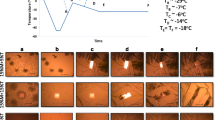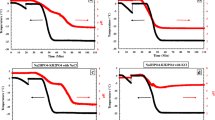Abstract
Purpose. To study the effect of cooling rate, the influence of phosphate buffers and polyvinylpyrrolidone (PVP) on the crystallization behavior of mannitol in frozen aqueous solutions.
Methods. Low-temperature differential scanning calorimetry and powder X-ray diffractometry were used to characterize the frozen solutions.
Results. Rapid cooling (20°C/min) inhibited mannitol crystallization, whereas at slower cooling rates (10°C and 5°C/min) partial crystallization was observed. The amorphous freeze-concentrate was characterized by two glass transitions at -32°C and -25°C. When the frozen solutions were heated past the two glass transition temperatures, the solute crystallized as mannitol hydrate. An increase in the concentration of PVP increased the induction time for the crystallization of mannitol hydrate. At concentrations of ≥100 mM, the buffer salts significantly inhibited mannitol crystallization.
Conclusions. The crystallization behavior of mannitol in frozen solutions was influenced by the cooling rate and the presence of phosphate buffers and PVP.
Similar content being viewed by others
REFERENCES
M. J. Pikal. Freeze-drying of proteins: Part I. Process design. Biopharm. 3:18–28 (1990).
E. Y. Shalaev and F. Franks. Changes in the physical state of model mixtures during freezing and drying: Impact on product quality. Cryobiology 33:14–26 (1996).
J. F. Carpenter, M. J. Pikal, B. S. Chang, and T. W. Randolph. Rational design of stable lyophilized protein formulations: Some practical advice. Pharm. Res. 14:969–975 (1997).
J. F. Carpenter and J. H. Crowe. An infrared spectroscopic study of the interactions of carbohydrates with dried proteins. Biochemistry 28:3916–3922 (1989).
K. Izutsu, S. Yoshioka, and T. Terao. Effect of mannitol crystallinity on the stabilization of enzymes during freeze-drying. Chem. Pharm. Bull. 42:5–8 (1994).
A. I. Kim, M. J. Akers, and S. L. Nail. The physical state of mannitol after freeze-drying: Effects of mannitol concentration, freezing rate, and a noncrystallizing cosolute. J. Pharm. Sci. 87: 931–935 (1998).
A. Burger, J. O. Henck, S. Hetz, J. M. Rollinger, A. A. Weissnicht, and H. Stottner. Energy/temperature diagram and compression behavior of the polymorphs of D-mannitol. J. Pharm. Sci. 89:457–468 (2000).
L. Yu, D. S. Mishra, and D. R. Rigsbee. Determination of the glass properties of D-mannitol using sorbitol as an impurity. J. Pharm. Sci. 87:774–777 (1998).
N. Murase and F. Franks. Salt precipitation during freezeconcentration of phosphate buffer solutions. Biophys. Chem. 34: 293–300 (1989).
L. Yu, N. Milton, E. G. Groleau, D. S. Mishra, and R. E. Vansickle. Existence of a mannitol hydrate during freeze-drying and practical implications. J. Pharm. Sci. 88:196–198 (1999).
R. K. Cavatur and R. Suryanarayanan. Characterization of phase transitions during freeze-drying by in situ X-ray powder diffractometry. Pharm. Dev. Technol. 3:579–586 (1998).
K.A. Pikal, and J.F. Carpenter. pH changes during freezing in sodium and potassium phosphate buffer systems in the presence of glycine: Effect on protein stability. PharmSci Suppl 1:S–544 (1998).
M. Yoshioka, B. C. Hancock, and G. Zografi. Inhibition of indomethacin crystallization in poly(vinylpyrrolidone) coprecipitates. J. Pharm. Sci. 84:983–986 (1995).
G. Van den Mooter, M. Wuyts, N. Blaton, R. Busson, P. Grobet, P. Augustijns, and R. Kinget. Physical stabilization of amorphous ketoconazole in solid dispersions with polyvinylpyrrolidone K25. Eur. J. Pharm. Sci. 12:261–269 (2001).
T. Matsumoto and G. Zografi. Physical properties of solid molecular dispersions of indomethacin with poly(vinylpyrrolidone) and poly(vinylpyrrolidone-co-vinylacetate) in relation to indomethacin crystallization. Pharm. Res. 16:1722–1728 (1999).
A. Martini, S. Kume, M. Crivellente, and R. Artico. Use of sub-ambient differential scanning calorimetry to monitor the frozenstate behavior of blends of excipients for freeze-drying. PDA J. Pharm. Sci. Technol. 51:62–67 (1997).
M. Reading, A. Luget, and R. Wilson. Modulated differential scanning calorimetry. Thermochim. Acta 238:295–307 (1994).
B. Luyet and D. Rasmussen. Study by differential thermal analysis of the temperature of instability of rapidly cooled solutions of glycerol, ethylene glycol, sucrose and glucose. Biodynamica 10: 1167–1191 (1968).
M. L. LeMeste and D. Simatos. Use of electron spin resonance for the study of “ante-melting” phenomenon observed in sugar solution by differential scanning calorimetry. Cryo Lett. 9:21–63 (1980).
S. Ablett, M. J. Izzard, and P. J. Lillford. Differential scanning calorimetric study of frozen sucrose and glycerol solutions. J. Chem. Soc. Faraday Trans. 88:789–794 (1992).
M. J. Izzard, S. Ablett, P. J. Lillford, V. L. Hill, and I. F. Groves. A modulated differential scanning calorimetric study: Glass transitions occurring in sucrose solutions. J. Therm. Anal. 47:1407–1418 (1996).
H. Levine and L. Slade. Thermomechanical properties of small-carbohydrate-water glasses and “rubbers”: Kinetically metastable systems at sub-zero temperatures. J. Chem. Soc. Faraday Trans. 84:2619–2633 (1988).
E. Y. Shalaev and F. Franks. Structural glass transitions and thermophysical processes in amorphous carbohydrates and their super-saturated solutions. J. Chem. Soc. Faraday Trans. 91:1511–1517 (1995).
L. Chang, X. Tang, M. J. Pikal, N. Milton, and L. Thomas. The origin of multiple glass transitions in frozen aqueous solutions. Proc. NATAS Annu. Conf. Therm. Anal. Appl. 27:624–628 (1999).
M. Yoshioka, B. C. Hancock, and G. Zografi. Crystallization of indomethacin from the amorphous state below and above its glass transition temperature. J. Pharm. Sci. 83:1700–1705 (1994).
A. Pyne, R. Surana, and R. Suryanarayanan. Crystallization of mannitol below Tg´ during freeze-drying in binary and ternary aqueous systems. Pharm. Res. 19:901–908 (2002).
Author information
Authors and Affiliations
Corresponding author
Rights and permissions
About this article
Cite this article
Cavatur, R.K., Vemuri, N.M., Pyne, A. et al. Crystallization Behavior of Mannitol in Frozen Aqueous Solutions. Pharm Res 19, 894–900 (2002). https://doi.org/10.1023/A:1016177404647
Issue Date:
DOI: https://doi.org/10.1023/A:1016177404647




